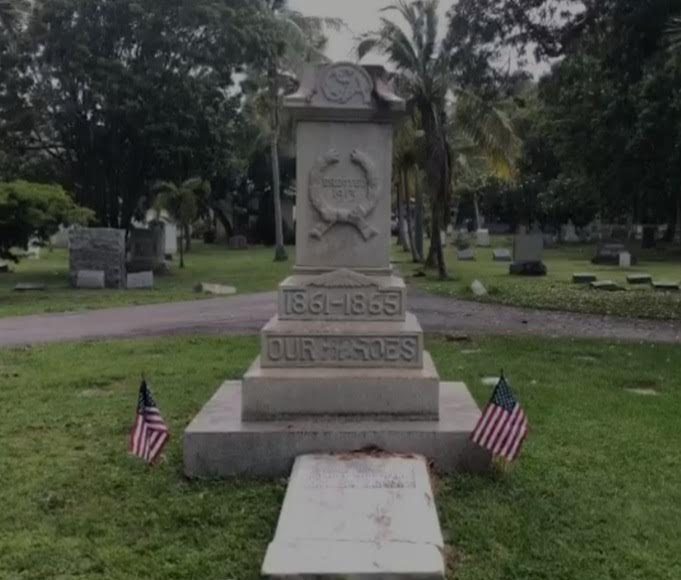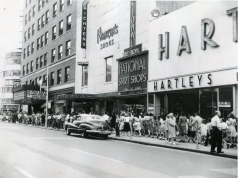A memorial to confederate soldiers and their cause has, for nearly a century, quietly shared sacred burial ground with some of Miami’s most celebrated civil-rights leaders and pioneers.
The memorial, commissioned in 1913 by the Southern Cross Chapter #796 of the United Daughters of the Confederacy (UDC), originally stood outside the Dade County Courthouse until 1927, before it was moved to its current location up the road at Miami City Cemetery.
Etched into one side of the monument is a confederate flag, with an inscription about the statue’s commissioners and the purpose behind the memorial.
It reads, “erected by the southern cross chapter United Daughters of the Confederacy to all who wore the grey. It is a duty we owe to posterity to see that our children shall know the virtues and become worthy of their sires.”
On the other side, an open-top wreath with the statue’s construction year in the middle sits above an inscription of 1861-1865, marking the period of the Civil War, the bloodiest conflict on American soil, with the phrase “Our Heroes” etched in all capital letters right below.
Over the past few years, Americans have begun to revisit and confront this nation’s history of racism, centered on the injustice of slavery, which the South advocated. As a result, communities across the country started tearing down and vandalizing monuments associated with the confederate cause. In some cases, these have also been vandalized.
Paul George is a resident historian at History Miami museum who runs tours of the Miami City Cemetery. The location of the UDC monument has allowed it to stand for so long, he explained.
“I think it has remained there in large measure because it’s so tucked away,” said George. “Other than my tours, there are probably 5 to 10 burials at most a year, people just don’t visit the cemetery, and now that it’s gated, it’s pretty much locked up.”
George says upkeep to the memorial circle grounds is still an occurring practice despite its long history, especially on Confederate Memorial Day – a state-sanctioned holiday – April 26th.
However, given the monument’s placement inside a city-owned cemetery, George says it is considered appropriate to be there.
“It’s there, it’s considered appropriate, those marble benches they were placed there in the last 10 to 15 years, so there is some activity on the part of the UDC,” said George. “And they do show up on Confederate Memorial Day, and they do oversee as far as I know the flag placements on gravesites of confederate veterans.”
Despite its off-the-beaten-path location, the UDC monument is no stranger to vandalism, having withstood a bath of red spray paint in 2019 when the words “killer,” “rapists,” “murderer,” and “ANTIFA” were smeared across.
The monument is the centerpiece of a wider memorial spot in the cemetery known as the confederate memorial circle.
Surrounded by UDC commissioned marble benches, some containing inscriptions of Bible verse Luke 2:29 (“Lord, now lettest thou thy servant depart in peace”), several palm trees, American flags, and a scattering of white flower vases containing an array of plastic red, white, and blue flowers.
The confederate memorial circle is a final resting place for 66 confederate veterans.
Ronnie Hurwitz, a long-time Miami native and self-appointed guardian of the Miami City Cemetery for over 30 years, says the monument should not be torn down.
“Keep your hands off it. What are you going to do, put it in a warehouse? You can’t erase history, put it in a museum or something, but I personally don’t believe we should remove them,” said Hurwitz.
Hurwitz, who’s part Jewish, says that he understands the history but that the monument was erected as a tribute for those confederate soldiers who died in the Civil War.
“I understand, I love history, I know there is a lot of hate in the world,” said Hurwitz. “To blacks, it would almost be like for Jews to see a Nazi flag in the cemetery, but you’re not seeing a Nazi flag. Instead, you see a monument for the war dead.”
Conversations surrounding the practice of displaying confederate statues and whether they should be removed or relocated from public view have recently grown into a hot-button political issue.
In June, the U.S House of Representatives voted 285-120 to remove Confederate statues from Capitol Hill.
According to data from Southern Poverty Law Center, and verification by public records portal Been Verified, Florida ranks fourth in the nation for the number and pace at which confederate statues being removed, with 54 active monuments and a 35% removal rating.
In contrast, when compared with its northern neighbors, Georgia, and Alabama, both states each have well over 100 monuments, and each has a removal rating below 10%.
Given that the cemetery is under jurisdiction of the the City of Miami Parks and Recreation department, Miami taxpayers pay for the upkeep of the cemetery grounds and monuments, including the confederate memorial circle.
For the last 94 years, the UDC monument has stood in the historic cemetery, second in prominence only to a memorial of Miami’s “founding mother,” Julia Tuttle.
The cemetery is also home to many Miami civil rights leaders, including Rev. Theodore Gibson, R.E.S Toomey, and Alex Lightbourne.
Marvin Dunn, a retired chairperson of psychology at FIU and author of “Black Miami in the 20th Century,” is opposed to removing Confederate monuments.
Instead of removal, Dunn calls for monuments recognizing African-American leaders and their accomplishments to be erected in the cemetery.
“That’s a powerful group (UDC), they have been for a long time, and if they want to have that monument there, then that’s why it’s there,” said Dunn. “If they are going to have a confederate monument in the City of Miami Cemetery, on public property, then so be it,” he said. He cited Miami’s first black millionaire, D.A Dorsey as someone worthy of a monument.
“If they want to have a confederate monument in the City of Miami Cemetery, let’s commission a monument for Mr. Dorsey, and the city should pay for it,” he said adding that it should be built in the same monumentally visible fashion as the UDC monument. This would serve a greater purpose than to simply remove the existing confederate monument.
“I find [these confederate monuments] offensive, very offensive,” said Dunn. “But on the other hand, to me, if you make equally visible, particularly on public property, our heroes that fought for and contributed to African American life and history, they should be exposed and presented as well.”

































